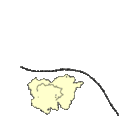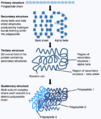Protein biosynthesis (synthesis) is when cells build proteins. The term is sometimes used to refer only to protein translation but more often it refers to a multi-step process.
Amino acids are either synthesised or eaten in food. Then, after the transcription of polypeptide genes, the amino acids are put together. This is done by translation and RNA splicing which produces messenger RNAs. The splicing process produces the final proteins, which then fold up into their protein structure. Then they can function. The plural is used here because, with most genes, the splicing process produces more than one final working protein. One particular Drosophila gene (DSCAM) can be alternatively spliced into 38,000 different mRNA.
Protein biosynthesis differs between prokaryotes and eukaryotes, though parts of the process are the same in both.
Images for kids
-
Protein biosynthesis starting with transcription and post-transcriptional modifications in the nucleus. Then the mature mRNA is exported to the cytoplasm where it is translated. The polypeptide chain then folds and is post-translationally modified.
-
Illustrates the conversion of the template strand of DNA to the pre-mRNA molecule by RNA polymerase.
-
Outlines the process of post-transcriptionally modifying pre-mRNA through capping, polyadenylation and splicing to produce a mature mRNA molecule ready for export from the nucleus.
-
Illustrates the translation process showing the cycle of tRNA codon-anti-codon pairing and amino acid incorporation into the growing polypeptide chain by the ribosome.
-
A ribosome on a strand of mRNA with tRNA's arriving, performing codon-anti-codon base pairing, delivering their amino acid to the growing polypeptide chain and leaving. Demonstrates the action of the ribosome as a biological machine which functions on a nanoscale to perform translation. The ribosome moves along the mature mRNA molecule incorporating tRNA and producing a polypeptide chain.
-
Shows the process of a polypeptide chain folding from its initial primary structure through to the quaternary structure.
-
Shows a post-translational modification of the protein by protease cleavage, illustrating that pre-existing bonds are retained even if when the polypeptide chain is cleaved.
-
Shows the post-translational modification of protein by methylation, acetylation and phosphorylation
-
Illustrates the difference in structure between N-linked and O-linked glycosylation on a polypeptide chain.
-
Shows the formation of disulphide covalent bonds as a post-translational modification. Disulphide bonds can either form within a single polypeptide chain (left) or between polypeptide chains in a multi-subunit protein complex (right).
-
A comparison between an unaffected individual and an individual with sickle cell anaemia illustrating the different red blood cell shapes and differing blood flow within blood vessels.
-
Formation of cancerous genes due to malfunction of suppressor genes.
See also
 In Spanish: Biosíntesis proteica para niños
In Spanish: Biosíntesis proteica para niños

 In Spanish: Biosíntesis proteica para niños
In Spanish: Biosíntesis proteica para niños









